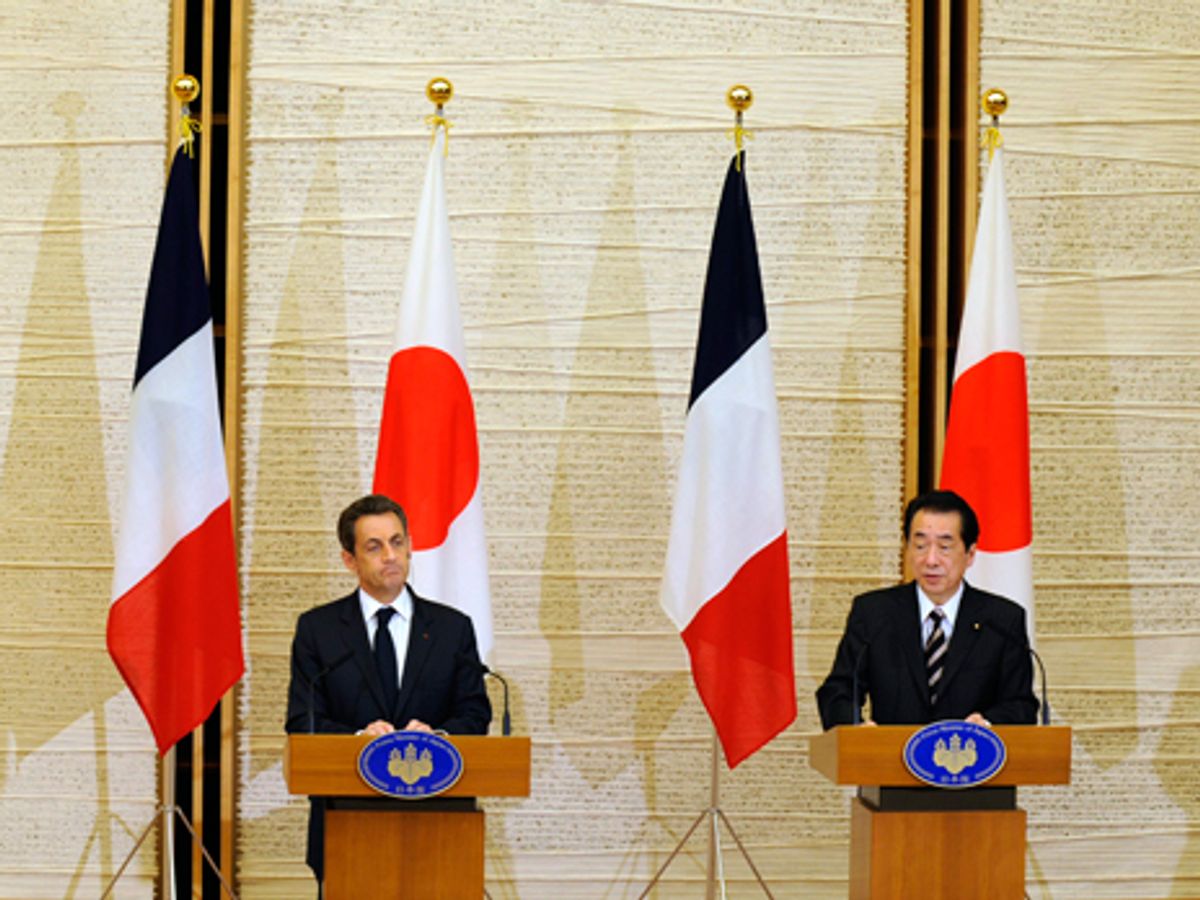Editor's Note: John Boyd is an IEEE Spectrum contributor reporting from Kawasaki, Japan. This is part of IEEE Spectrum's ongoing coverage of Japan's earthquake and nuclear emergency. For more details on how Fukushima Dai-1's nuclear reactors work and what has gone wrong so far, see our explainer and our timeline.
Radiation levels continue to climb in the area surrounding the Fukushima Dai-1 nuclear plant, and the Japanese government is considering a scheme of spraying resin over the radioactive debris and dust that litters the nuclear complex, in an effort to keep it contained. Meanwhile, French President Nicolas Sarkozy, on a visit to Japan, said the two countries had agreed to work together to draw up international nuclear safety standards.
Hidehiko Nishiyama, the deputy director general of the Nuclear and Industrial Safety Agency (NISA), said Thursday in a morning press briefing that radiation in the seawater sampled on Wednesday 330 meters south of the stricken Dai-1 plant had risen to 4385 times maximum safety level, a rise from the previous high of 3355 times the maximum that was detected on Tuesday. The agency said 180 becquerels per cubic centimeter of radioactive iodine-131 had been detected, as well as increases in cesium.
Worry about radioactive material entering the ocean was heightened days ago, when TEPCO found contaminated water in tunnels, called trenches, which lie between the reactors and the ocean. The company reported Thursday that it had pumped 150 tons of contaminated water from the trench outside the No. 1 turbine room to an outside storage tank near the No. 4 reactor building. The water in this trench was close to overflowing Wednesday, but TEPCO said that the level in the inspection shaft has now dropped by 1 meter. Pumping work also continues in the turbine basements of reactors numbers 1, 2 and 3 in order to remove the contaminated water that has pooled there.
Radiation levels were higher on land as well. In a Wednesday briefing in Vienna the International Atomic Energy Agency (IAEA) said that one of its two teams measuring radiation levels in Japan had been testing soil samples taken from 18 March to 26 March at distances of 25 to 58 kilometers from the Dai-1 plant. The nuclear watchdog said that measurements of iodine-131 and cesium-137 indicated “that one of the IAEA operational criteria for evacuation is exceeded in Iitate village. We advised the (Japan) counterpart to carefully assess the situation.” Iitate village is about 40 km from the plant and so lies well outside the 20 km evacuation zone.
In addressing this warning, Yukio Edano, the chief cabinet secretary, said that the government recognized that the radiation levels were high and if they continued “over a long period of time” could affect people’s health. He added that the government would step up monitoring efforts and would consider extending the evacuation zone if necessary.
Unusual efforts may be in the offing to limit the spread of radioactive materials. Various media reports said the government planned to begin spraying a synthetic resin over the radioactive debris and dust that littered the area inside the plant site. The debris is the result of several hydrogen explosions that wrecked three of the reactor buildings in the complex. The aim of the resin spray is to prevent radioactive dust from dispersing outside the site. The Daily Yomiurinewspaper, citing unnamed sources, said that the operation would likely begin Thursday, last two weeks, and cover an area of some 80 000 square meters. A remote-controlled robot would be used to conduct the spraying.
Separately, Japan is expecting help from another nation heavily dependent on nuclear power—France. Nuclear experts from Areva, a French publicly owned nuclear fuel conglomerate, are helping TEPCO in its battle to bring the Fukushima plant under control. The company processes uranium-plutonium mixed-oxide (MOX) fuel for Japanese nuclear power companies. MOX is the fuel used in the No. 3 reactor of the Fukushima plant. Two Areva experts are already in Japan and were joined Wednesday by Anne Lauvergeon, chairman of the company, and several more experts.
An official at Areva’s Japan subsidiary said that the Areva experts would first discuss with Japanese authorities and TEPCO what kind of help in particular they could provide. The company’s Web site says it chartered a plane soon after the earthquake struck to ship to Japan 3000 activated charcoal protective masks, 10 000 overalls and thousands of gloves, as well as 100 metric tons of boric acid, which is used to absorb neutron radiation.
President Sarkozy of France, as chair of the G20 and G8, flew to Japan Thursday to show unity with the nation during its time of crisis and to find out what additional help the G20 and G8 countries might offer. During an evening press conference with Prime Minister Naoto Kan, Sarkozy said that international nuclear safety standards did not exist, and that this must change. Sarkozy and Kan said that France and Japan would work together to design such standards. Sarkozy also said that the nuclear crisis would be on the agenda at the Group of Eight summit in May.




